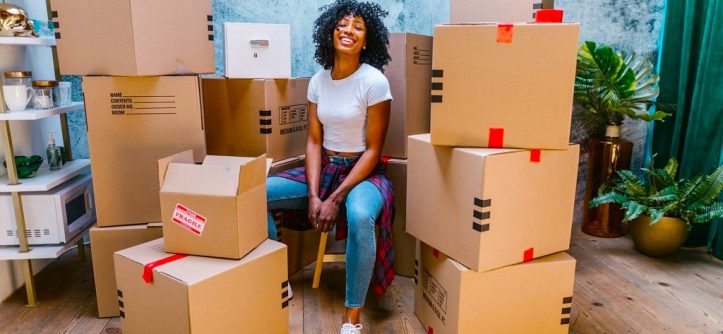Good organisation, high motivation, and some helpers around you –are all positive factors for hassle-free removal.
Yet, without a detailed checklist, don’t expect fantastic results at all. Procedures such as moving out require your total concentration and attention. We don’t have them with this stress, excitement, and so many things to do in a short time.
If you want everything to go smoothly, we highly recommend using our ultimate moving checklist. Below are the basics to step on and create your to-do timeline for the procedure.
Begin with proper sorting and decluttering
Before a removal, nothing can stress you more than the chaos you have right now in your current home.
The more extensive clutter, the more disturbed you will feel about moving all these things. But you don’t have to start the process with such a negative attitude. Clear the chaos away to pack decently and smartly.
Here’s a big bunch of decluttering tips that might be very useful for you:
- Sort out the items and take with you only what you need. Don’t forget that you are starting a new life and in a new home. Isn’t it time for you to eliminate all these unnecessary material things? Instead, donate them to someone in need.
- There’s a way to make money from decluttering. It involves some downsizing again. This time, though, instead of a donation, make a sale. Try to get as much money as possible from all your unnecessary but functional belongings, and this time, spend the cash on emotions rather than on things.
- While decluttering, consider where each item will go. Make notes about whether and how many delicate or fragile things you must consider. Have a look at all the furniture pieces and see if there’s a way to dismantle them for eraser transportation.
Book a moving company on time not to regret it later
While decluttering, you might estimate your situation in the best way. Try to ask yourself if you can handle the complete removal independently, including transporting all your belongings to your new home.
Whatever you cannot do, leave it to the specialists. Thankfully, today in the UK, we have plenty of excellent and high-quality moving companies to rely on. It’s critical to contact them as early as possible. This is how you will avoid paying for an emergency service.
Plus, when you have more time, you can do research and find the hottest man and van deal.
Buy, borrow, or get your moving supplies
At least two months before the removal date, get all the necessary moving supplies.
We suggest you opt for the early equipment because people usually find it challenging to consider how many moving boxes they need and whether they should buy some special tools to wrap the delicate items or rent storage units.
There are many options to equip yourself for the packing day:
- Get everything you already have to be used as moving supplies – suitcases, bags, knapsacks, shoe boxes, old but impact cardboard boxes, electric device boxes, and containers.
- Ask someone to land you some moving boxes. Do you know someone who’s recently moved out? Ask him for assistance! Do you use social media? Use it for something helpful this time by visiting a moving-out group where people land, give for free, or share where to find second-hand
- Go to the supermarket. Buy some tape proof-safe your baggage finely, and meanwhile, ask the consultant if there’s any chance for her to give you a couple of old cardboard boxes. If you have to, wait until the store’s next delivery date.
- Buy everything you need. It is worth it to get some free cardboard boxes because they are not cheap at all. Yet, you can re-sell them in the same social media groups we’ve mentioned above.
Pack one room at a time on mandatory
If you want to save time, packing is the best phase of the removal process to do so. When you pack one at a time, you can definitely save at least an hour for quite a relaxation before the alarm for the next chore hits you. In addition, such a packing routine will prevent any chaotic actions or placing the items without logic. Eventually, you will find yourself in the same mess a bit later during the unpacking process.
The labelling moving system for the boxes is a must
Here’s one more hack to minimise the stress when unpacking: know where everything is. This is not hard to be achieved at all. You just need to stick to the labelling system. All you have to do is make up a system to guess what’s inside any box.
Here are some examples:
- The colour Add some big dots in a concrete shade depending on the types of items (red for clothes, blue for kitchen accessories, etc.).
- Simply write with words what’s inside the box. Use a permanent marker. While being in the van, the friction of all moving supplies might delete your notes.
- Label the boxes by rooms – bedroom, kitchen, bathroom, etc.
Embrace the inventory arrangement
Once the moving-out day gets closer, people tend to become more nervous. The fuss, the rush, and the emotions can blur your mind. And all those labels you’ve made can fly away from your currently absent-minded head.
If you have made an inventory in advance, you should not remember anything by heart. Simply have keys in your inventory on what’s the indication of each label.
Take care of fragile and heavy items the proper way
Be careful with them because you can damage them while hurrying to pack everything. During transportation, there’s a big chance for breakages to appear.
Avoid such miserable situations and instead, have in mind the following tips:
- For heavy items: use dollies, sliders, and other lifting tools to take them safely to the van. Before that, make sure to place the heavy items at the bottom of the box. On top of them, you can arrange some light items like clothes, makeup, kitchen utensils, etc.
- For fragile items: wrapping is the most secure way to protect them from cracks, scratches, and full destruction. Use bubble wrap for this purpose. If you don’t have such, you can coat each fragile item with a blanket instead. Attention: do not place fragile items with other belongings in the same box.
Get insurance, if possible
The more luxurious items you possess, the more you need insurance.
We have good news: almost any trustworthy moving company will offer you one. Even more impressive is that the movers are usually fully vetted and insured, too. Just ensure your selected company has such a clause in the service contract.
This was a detailed enough moving checklist. Here’s one more piece of insurance for you: if you complete all of its points, your removal will go smoothly and without sweating.




